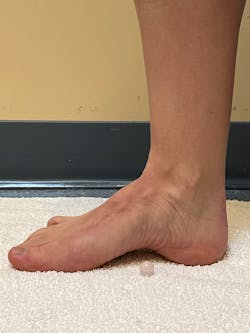Health & Wellness: Barefoot Training: A Big Impact on Small Footprints
Whether carrying heavy tools, climbing ladders, managing wildland terrain or moving patients, your job’s activities require the ability to stand and walk safely. The foot is the base of support for the rest of the body and plays a significant role in the body’s capability to move in different directions. Therefore, it’s important to keep the foot both strong and flexible. A highly effective way to do this is through barefoot training.
Wearing shoes or boots actually impedes the development of proper foot health and movement. Additionally, if the shoes that you exercise in or the boots that you wear throughout a work shift aren’t the correct fit for your specific foot type, your overall health and work performance can be affected negatively.Shoes off
Regardless of your foot type, barefoot training might help to decrease your risk of injury and to improve your overall wellness.
To help to maintain an appropriate balance of flexibility and stability, the arches are supported by ligaments that hold bones together and by muscles that are in the foot and lower leg. There are four layers of muscles along the bottom of each foot. When you wear shoes all day, these muscles don’t work as strenuously as when you are barefoot. This leads to weaknesses and muscle imbalances within the foot and, subsequently, puts you at a significantly higher risk of developing pain and injury.
Throughout your day, how much time do you spend barefoot?
When barefoot, the muscles that are in the bottom of the foot are required to work and, therefore, stay strong. Developing and maintaining the strength of the foot muscles provide for decreased risk of muscle imbalances throughout the body and, thus, a decreased risk of injury.
Barefoot training
Barefoot training is a great way to increase muscle strength, balance and endurance as well as to decrease the risk of injury. However, this type of training should be incorporated into a fitness program gradually and completed with caution. If done inaccurately, barefoot training can cause more harm than good.
Prior to beginning any type of exercise program, you should receive medical clearance from a qualified healthcare professional. It also is important to consider prior activity level, previous or current injuries, current pain and type of foot. Just as each individual tactical athlete’s fitness, health and wellness needs are specific and unique, so, too, are one’s barefoot training exercises.
There are different ways to slowly incorporate barefoot training into your health and fitness program. When you are off shift, you can start your training by walking around your home barefoot. The foot reacts differently to the ground and to various movements when it’s bare compared with when it’s in a shoe/boot.
When you become more comfortable walking barefoot, you can incorporate barefoot training slowly into your fitness program, including endurance and strength training exercises. Anything other than a slow progression can lead to injury.
It’s important to never complete barefoot training with power exercises or exercises in which there is a high probability of dropping heavy weights on your feet.Individuals who have flat feet should incorporate exercises into their training that increase the stability of the foot. One way to do this is to increase the strength of the muscles that are in the bottom of the foot. An effective exercise to practice is arch lifts. For this exercise, sit in a chair with your bare feet flat on the floor. The ankles should be directly under your knees, and both legs should remain parallel to each other. Keeping your heel and toes flat on the floor (don’t curl your toes), slide the ball of your foot toward your heel by contracting the muscles on the bottom of your foot. Hold this muscle contraction for three seconds before relaxing, and then repeat. The purpose of arch lifts is to increase the medial arch of your foot.
Individuals who have high arch feet want to focus more time on increasing the flexibility of the foot. An important stretch to incorporate into your fitness program is the toe extension. To do this stretch, sit in a chair with both bare feet flat on the floor. Your toes should be under your knees. Keeping your toes flat on the floor, lift both heels as high as possible until you feel a stretch in the bottom of your foot. The toes should remain as straight as possible throughout this stretch. Hold this exercise for 30 seconds before relaxing, and then repeat.
Individuals who have a neutral foot type should incorporate stability and flexibility exercises into their barefoot training regimen equally. This allows for these individuals to maintain an appropriate balance within the lower extremities.
Doing the same foot exercises day in and day out without making any changes to your routine will cause your lower leg muscle strength and endurance to plateau. This will mean that you won’t continue to progressively make additional gains.
Flexibility and stability
Your foot type and the barefoot training that you do play an important role in your overall fitness, health and wellness. To limit your risk of injury and to most effectively perform your job duties, the foot must be flexible enough to absorb forces from the ground but also provide enough stability to maintain the integrity of the foot, ankle and lower leg. Not only is too much flexibility detrimental to your overall health, but too much stability also negatively affects the body. It’s important that you and your department work together to establish a wellness program that includes barefoot fitness training.
Foot Type
About the Author

Jessica Scott
Jessica Scott is a Doctor of physical therapy, a certified athletic trainer, and a tactical strength and conditioning facilitator. She received her undergraduate degree in athletic training and sports medicine and her Doctorate of physical therapy from Quinnipiac University. As the daughter of a firefighter, Scott grew up seeing the physical demands and requirements of the firefighting profession. Therefore, she started New England Tactical Sports Medicine, which is dedicated to improving the health and wellness of tactical athletes and provides rehabilitation services, educational seminars regarding injury prevention, and fitness programs to promote healthy lifestyles and improved physical performance.




